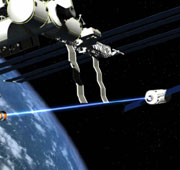Beam Me to Mars"Are we there yet?" Everyone has faced this exasperating question from impatient companions on a long road trip. Imagine if the trip lasted six months. One way.
With conventional rockets, a roundtrip to Mars could last as long as three years, because an extended stay is required while the orbits of Earth and Mars align again for the return trip.
But an exciting NASA-funded research project could send astronauts racing to Mars up to six times faster. The solution -- proposed by Dr. Robert Winglee of the University of Washington -- sounds like science fiction. A spacecraft rides a beam of plasma, which is electrified and magnetized gas, all the way to Mars and back. The roundtrip journey could be wrapped up in about 90 days using Winglee's Magnetized Beam Plasma Propulsion system, dubbed Magbeam.
How It Works and Where It Came From
The system would use space stations to generate the plasma and beam it to a spacecraft. The spacecraft generates its own magnetic field, which deflects the plasma beam. Like wind pushing on an umbrella, the deflection of the plasma beam generates a force that propels the spacecraft. Another space station orbiting the destination generates a beam to slow down the spacecraft upon its arrival, and to launch it on the return journey.
adapted from www.nasa.gov



